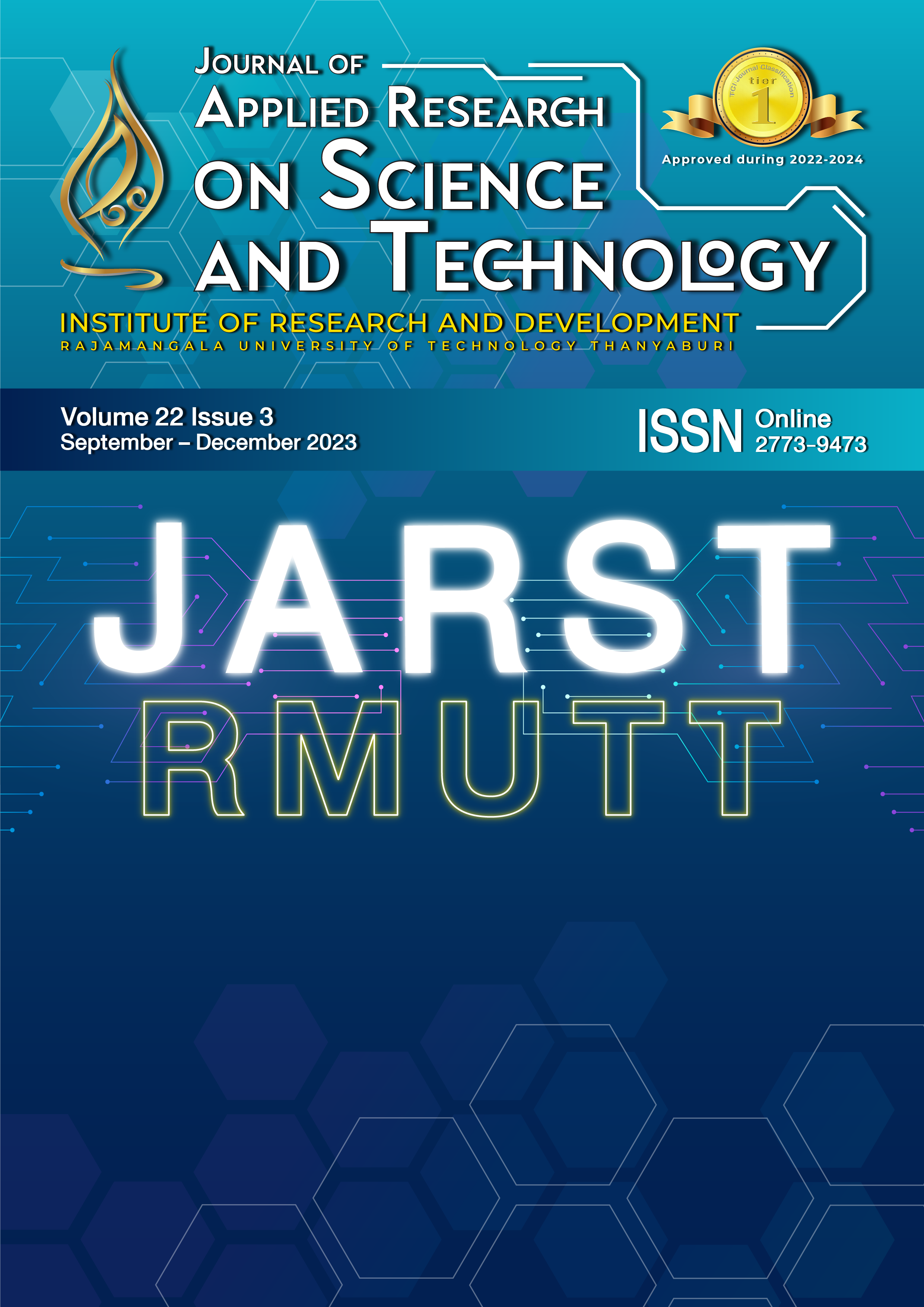Development of a photoelectrocatalytic method to improve the efficiency of E. coli removal
Main Article Content
Abstract
The photoelectrocatalytic technology has attracted significant attention for effectively eliminating organic matter and microbiological pollutants in the environment, owing to its remarkable efficiency and low power consumption. The major goal of this research is to develop and determine the optimal conditions that will facilitate the photoelectrocatalytic technique's enhancement of E. coli eradication. The WO3/BiVO4 photoanode was fabricated on a conductive glass substrate using the automatic dip coating process, employing a layer-by-layer deposition method. Subsequently, the WO3/BiVO4 photoanode was calcinated at 550 °C for 60 minutes. The produced WO3/BiVO4 electrodes were employed as working electrodes to investigate and determine the optimal parameters for enhancing the eradication of E. coli process. The primary factors investigated in this study were the concentration of KCl electrolyte solution and the applied potential. These parameters were examined to identify the best circumstances that would result in the highest efficiency for the degradation of E. coli in a photoelectrochemical system. The study also aimed to comprehend the catalytic mechanism implicated in eliminating E. coli by implementing three different processes: photocatalysis, electrocatalysis, and photoelectrocatalysis. We discovered that the key factors directly influencing E. coli eradication effectiveness under the photoelectrocatalytic process were applied potential and electrolyte solution concentration. The optimum conditions eliminated 99.99% of E. coli in 150 minutes with an initial concentration of 106 CFU/ml, an electrolyte concentration of 0.01 M KCl, and an applied potential of 2.0 V. The study confirmed photoelectrocatalytic cells' efficacy in removing microorganisms and recommended their application in a wider range of wastewater treatment systems.
Article Details

This work is licensed under a Creative Commons Attribution-NonCommercial-NoDerivatives 4.0 International License.
References
Oliveira R, Silva RM, Castro AR, Rodrigues LR, Pereira MA. 10 - Biological processes and the use of microorganisms in oily wastewater treatment. In: Basile A, Cassano A, Rahimpour MR, Makarem MA, editors. Advanced Technologies in Wastewater Treatment: Elsevier; 2023. p. 257-88.
Techaoei S. Bacterial and fungal contamination of personal care product in Northern Thailand. J Appl Res Sci Tech. 2017;16(1-2):32-8.
Maniakova G, Polo-López MI, Oller I, Abeledo-Lameiro MJ, Malato S, Rizzo L. Simultaneous disinfection and microcontaminants elimination of urban wastewater secondary effluent by solar advanced oxidation sequential treatment at pilot scale. J Hazard Mater. 2022;436:129134.
Srevarit W, Moonmangmee S, Phapugrangkul P, Kuboon S, Klamchuen A, Saito N, et al. Photoelectrocatalytic H2 evolution enhancement over CuO-decorated TiO2 nanocatalysts and promoting E. coli degradation. J Alloy Compd. 2021;859:157818.
Seekhaw P, Chuaboonmee R, Surayot P, Chadpan S, Thurnkul N. Evaluation of phytochemical screening, antioxidant and antimicrobial activities from ethanolic extracts of the Flacourtia indica (Burm.f.) Merr. fruits. J Appl Res Sci Tech. 2020;19(1):124-36.
Rather RA, Lo IMC. Photoelectrochemical sewage treatment by a multifunctional g-C3N4/Ag/AgCl/BiVO4 photoanode for the simultaneous degradation of emerging pollutants and hydrogen production, and the disinfection of E. coli. Water Res. 2020;168:115166.
Dang Q, Wang L, Liu J, Wang D, Chai J, Wu M, et al. Recent progress of photoelectrocatalysis systems for wastewater treatment. Journal of Water Process Engineering. 2023;53:103609.
Chen W, Liu S, Fu Y, Yan H, Qin L, Lai C, et al. Recent advances in photoelectrocatalysis for environmental applications: Sensing, pollutants removal and microbial inactivation. Coordin Chem Rev. 2022;454:214341.
Liu J, Ma N, Wu W, He Q. Recent progress on photocatalytic heterostructures with full solar spectral responses. Chemical Engineering Journal. 2020;393:124719.
Nareejun W, Ponchio C. Novel photoelectrocatalytic/solar cell improvement for organic dye degradation based on simple dip coating WO3/BiVO4 photoanode electrode. Sol Energ Mat Sol. 2020;212:110556.
Arunima SR, Deepa MJ, Nair AJ, Shibli SMA. Exploration of WO3/BiVO4 composite based hot-dip zinc coating to combat biocorrosion. Materials Science and Engineering: B. 2021;271:115302.
Reynolds J. Serial dilution protocols. American Society for Microbiology: Washington, DC, USA. 2005:1-7.
Qi Z, Li G, Wang M, Chen C, Xu Z, An T. Photoelectrocatalytic inactivation mechanism of E. coli DH5α (TET) and synergistic degradation of corresponding antibiotics in water. Water Res. 2022;215:118240.
He H, Sun S, Gao J, Huang B, Zhao T, Deng H, et al. Photoelectrocatalytic simultaneous removal of 17α-ethinylestradiol and E. coli using the anode of Ag and SnO2-Sb 3D-loaded TiO2 nanotube arrays. Journal of Hazardous Materials. 2020;398:122805.
Li G, Yang C, He Q, Liu J. Ag-based photocatalytic heterostructures: Construction and photocatalytic energy conversion application. Journal of Environmental Chemical Engineering. 2022;10(3):107374.
McMichael S, Tolosana-Moranchel A, Cortes MALRM, Hamilton JWJ, Fernandez-Ibanez P, Byrne JA. An investigation of photoelectrocatalytic disinfection of water using titania nanotube photoanodes with carbon cathodes and determination of the radicals produced. Applied Catalysis B: Environmental. 2022;311:121339.
Thongthep P, Moonmangmee S, Ponchio C. Solar/photoelectrocatalytic cell development for H2 production and simultaneous organic dye degradation. Mat Sci Semicon Proc. 2021;124:105597.


